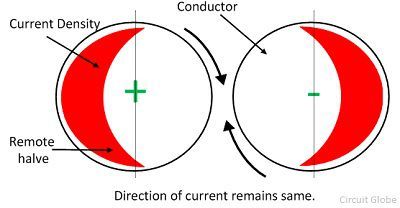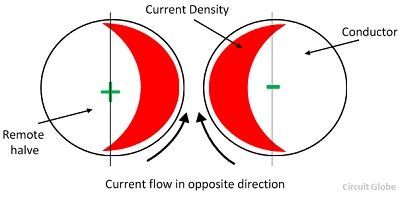Definition: When the conductors carry the high alternating voltage then the currents are non-uniformly distributed on the cross-section area of the conductor. This effect is called proximity effect. The proximity effect results in the increment of the apparent resistance of the conductor due to the presence of the other conductors carrying current in its vicinity.
When two or more conductors are placed near to each other, then their electromagnetic fields interact with each other. Due to this interaction, the current in each of them is redistributed such that the greater current density is concentrated in that part of the strand most remote from the interfering conductor.
If the conductors carry the current in the same direction, then the magnetic field of the halves of the conductors which are close to each other is cancelling each other and hence no current flow through that halves portion of the conductor. The current is crowded in the remote half portion of the conductor.
When the conductors carry the current in the opposite direction, then the close part of the conductor carries, the more current and the magnetic field of the far off half of the conductor cancel each other. Thus, the current is zero in the remote half of the conductor and crowded at the nearer part of the conductor.
If DC flows on the surface of the conductor, then the current are uniformly distributed around the cross section area of the conductor. Hence, no proximity effect occurs on the surface of the conductor.
The proximity effect is important only for conductor sizes greater than 125 mm2.Correction factors are to be applied to take this fact into account.
If Rdc – uncorrected DC level of the core
Ys – skin effect factor, i.e., the fractional increment in resistance to allowing for skin effect.
yp – proximity effect factor, i.e., the fractional increment in resistance to allowing for skin effect.
Re – effective or corrected ohmic resistance of the core.
The allowance for proximity effect is made, the AC resistance of the conductor becomes
![]() The resistance Rdc is known from stranded tables.
The resistance Rdc is known from stranded tables.
Factors Affecting the Proximity Effect
The proximity effect mainly depends on the factors like conductors material, conductor diameter, frequency and conductor structure. The factors are explained below in details
- Frequency – The proximity increases with the increases in the frequency.
- Diameter – The proximity effect increases with the increase in the conductor.
- Structure – This effect is more on the solid conductor as compared to the stranded conductor (i.e., ASCR) because the surface area of the stranded conductor is smaller than the solid conductor.
- Material – If the material is made up of high ferromagnetic material then the proximity effect is more on their surface.
How to reduce Proximity Effect?
The proximity effect can be reduced by using the ACSR (Aluminum Core Steel Reinforced) conductor. In ACSR conductor the steel is placed at the centre of the conductor and the aluminium conductor is positioned around steel wire.
The steel increased the strength of the conductor but reduced the surface area of the conductor. Thus, the current flow mostly in the outer layer of the conductor and no current is carried in the centre of the conductor. Thus, reduced the proximity effect on the conductor.



Superb information given
nice 🙂
Very nicely explained.
Easy and complete information about any topic…..
Best information…
Very nice.
Thanks a lot, ” Circuit Globe ” Team for Sharing this … This will be helpful for me while writing my Semester Exam’s Theory paper of Power System😊
Proximity effect also known as……………?